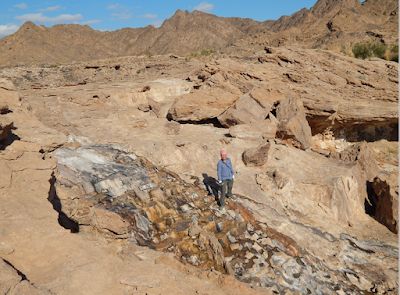原文網址:https://news.asu.edu/20220113-weathering-rocks-hold-clues-earths-great-oxidation-event
大概在24億年前,地球的大氣歷經了大氧化事件。在此之前早期地球的氧分子比現在少了許多。而在大氧化事件之後,氧分子開始大量增加,最終讓我們這樣的生命得以出現。
主要作者James Andrew站在阿曼一座強鹼性的泉水旁邊。現在這座湧泉流經的厚層碳酸鈣是數千年來從泉水當中沉澱出來的。背景則是由超基性岩形成的山脈。圖片來源:Everett Shock/ASU
數十年來,研究人員一直在試著瞭解大氧化事件的發生原因與時間點。
James Andrew Leong、Tucker
Ely(兩位都在2020獲得亞利桑那州立大學地球與太空探索學院的博士學位)以及亞利桑那州立大學的教授Everett
Shock主持的科學團隊判斷岩石風化或許是大氧化事件的成因之一。他們的結果最近發表在《自然通訊》(Nature
Communications)。
植物以及光合微生物會產生氧分子,但是生物以及岩石裡的鐵、硫、碳和其他元素氧化時則會消耗氧分子。此外,岩石風化過程中產生的還原性氣體,像是氫氣也會跟氧分子作用而消耗掉它們。
「這就像是你的支出比收入還多的時候,存摺裡的錢就不會增加一樣。早期地球的狀況似乎便是如此,」共同作者,亞利桑那州立大學地球與太空探索學院暨分子科學院的Shock表示。
在此假設下大氧化事件要發生,氧氣的消耗速率就必須隨時間減緩,這樣氧氣才能在大氣中持續累積。
有鑑於此,Leong和團隊試著判定早期地球有哪些作用會讓氧氣的消耗速率逐漸降低,使得氧氣隨之增加。
「我們知道大概不是生物的耗氧作用,因為在跟著產生氧氣的光合作用同步增加這方面,它們做得很不錯,」Shock表示。「所以我們認為岩石風化過程中氧氣消耗的速率可能形成了這些改變。」
為了驗證他們的假設,Leong和團隊把重點放在一種岩石的風化作用。這種稱為「超基性岩」的火成岩富含鎂和鐵,矽的含量則較低。
超基性岩為地球上部地函的主要成分,它們形成於此處的高溫之中。當這些岩石被帶到地表並且跟水接觸,岩石組成裡不含水的礦物會被轉變成含水礦物。由於過程中主要生成的置換礦物為蛇紋石,因此稱為「蛇紋石化作用」。這也會讓參與反應的地下水鹼度提高,其中含有的氣體也跟著增加,特別是氫氣。
他們這項研究的靈感來自之前的研究,他們在現今的阿曼的超基性岩山體中,發現了富含氣體的超鹼性液體並加以研究。該成果發表於2021年美國地質學會的《地球物理研究期刊》。
 |
| 作者在阿曼進行野外調查時拍下的照片。超基性岩和地下水發生化學反應之後會形成高鹼性的水。當這些水流回地表會和大氣中的二氧化碳反應而形成碳酸鈣,也就是照片當中的白色礦物。圖片來源:Leong/Shock/ASU |
「我們之前在阿曼的野外研究促使我們猜想早期地球的地表和大氣會是什麼情形?當時這種Ph值高且富含氫氣的液體相當普遍,就和現今接近中性的地下水與河水一樣,」Leong表示。「時至今日我們已經很難在地表看到類似那些在阿曼找到的超基性岩,但是在溫度較高的早期地球它們卻很常見。」
他們在進行分析的時候運用了共同作者Ely研發的程式碼來進行電腦模擬,藉此預測早期地球常見的數千種岩石成分產生氫氣的能力有多強。結果可以讓他們得出岩石成分與它們產生氫氣並消耗氧氣的能力之間的關聯。
運用模擬結果,團隊接著便能重建早期地球的蛇紋石化作用如何改變全球氫氣產生及氧氣消耗的速率,因而判斷出超基性岩的風化作用可能有助於大氧化事件發生。
「我們成功模擬了可能出現在早期地球的數千種岩石成分會進行的置換作用,」Leong說。「我們的計算顯示這些岩石成分當中有很多,尤其是像今日阿曼找到的那些成分十分超基性或者富含鎂的岩石,它們產生氫氣的能力非常優秀而可以防止氧氣累積在大氣。因此在接近太古宙末期,地表超基性岩的數量減少可能推動了大氧化事件發生。」
Weathering rocks hold clues to Earth's
Great Oxidation Event
About 2.4 billion years ago, Earth’s
atmosphere underwent what is called the Great Oxidation Event (GOE). Prior to
the GOE, early Earth had far less molecular oxygen than we have today. After
the GOE, molecular oxygen began to increase in abundance, eventually making
life like ours possible.
For decades, researchers have tried to understand why
and how the GOE occurred.
A team of scientists, led by James Andrew Leong with
Tucker Ely (both of whom earned their doctoral degrees from ASU’s School of
Earth and Space Exploration in 2020) and ASU Professor Everett Shock, has
determined that weathering rocks might have contributed to the GOE. Their
results were recently published in Nature
Communications.
Molecular oxygen is produced by plants and
photosynthetic microbes, but molecular oxygen is also consumed by organisms and
by the oxidation of iron, sulfur, carbon and other elements in rocks. Molecular
oxygen can also be consumed through reaction with reduced gases like hydrogen,
which can form during rock weathering.
Scientists studying the early Earth hypothesize that
the consumption of oxygen was perhaps more rapid than the production of oxygen
by photosynthesis, so oxygen was not able to accumulate in the atmosphere.
研究早期地球的科學家推測當時氧氣的消耗速率可能比光合作用產生氧氣的速率還快,因此大氣裡的氧氣才無法持續累積。
“It’s like when your bills exceed your income, money
can’t accumulate in a savings account. This appears to have been the situation
on the early Earth,” said co-author Shock, of ASU’s School of Earth and Space
Exploration and the School of Molecular Sciences.
For the GOE to occur under this hypothesis, the
consumption of oxygen had to slow with time, so that oxygen could build up in
the atmosphere.
Given that, Leong and his team set out to determine
what processes could be slowing down the consumption of oxygen on the early
Earth to produce an increase in oxygen.
“We know it’s probably not biological consumption,
which does a decent job of keeping up with oxygen production by photosynthesis,”
Shock said. “So we thought maybe the rate that oxygen was consumed by the
weathering of rocks was creating this change.”
To test their hypothesis, Leong and his team focused
on the weathering of a type of rock known as “ultramafic,” an igneous rock,
rich in magnesium and iron, with low silica content.
Ultramafic rocks comprise most of the Earth's upper
mantle, where they were formed at high temperatures. When these rocks are
brought to the surface and come into contact with water, the waterless minerals
that make up these rocks transform into minerals containing water. This process
is called serpentinization, after the main replacing mineral, serpentine. The
process also transforms the reacting groundwater into a highly alkaline water
with elevated gas content, in particular, hydrogen.
They were inspired to do this by research they had
conducted previously on hyperalkaline and gas-rich fluids found in the ultramafic
mountains of present-day Oman that was published in the AGU’s Journal of
Geophysical Research in 2021.
“Our previous field research in Oman led us to wonder
what the early Earth surface and atmosphere would have looked like when high pH
and hydrogen-rich fluids were as common as today's near-neutral pH groundwater
and rivers," Leong said. “Ultramafic rocks like those found in Oman are
rare in the Earth’s surface at the present-day, but were abundant during the
hotter early Earth.”
For their analysis, they conducted computer
simulations, based on a computer code that co-author Ely developed, to predict
the hydrogen generation potentials of thousands of rock compositions that were
common during the early Earth. From there, they could then draw connections
between rock compositions and their potentials to generate hydrogen and consume
oxygen.
With those simulations, the team then was able to
reconstruct the global hydrogen production and oxygen consumption rates via
serpentinization during early Earth and determine that the weathering of
ultramafic rocks could have helped facilitate the GOE.
“We were able to model the alteration of thousands of
rock compositions that are likely to be present on the early Earth,” Leong
said. “Our calculations show that many of these rocks, especially those that
are really ultramafic in composition or rich in magnesium, like those found in
Oman today, have very high potentials to generate hydrogen gas and help prevent
accumulation of oxygen. The decline in the abundance of ultramafic rocks in the
Earth’s surface towards the end of the Archean eon could have helped facilitate
the Great Oxidation Event.”
原始論文:James
Andrew M. Leong., Tucker Ely, Everett L. Shock. Decreasing extents of Archean serpentinization contributed to the rise
of an oxidized atmosphere. Nature
Communications, 2021; 12 (7341) https://doi.org/10.1038/s41467-021-27589-7
引用自:Arizona
State University. “Weathering rocks hold clues to Earth's Great Oxidation Event”

沒有留言:
張貼留言